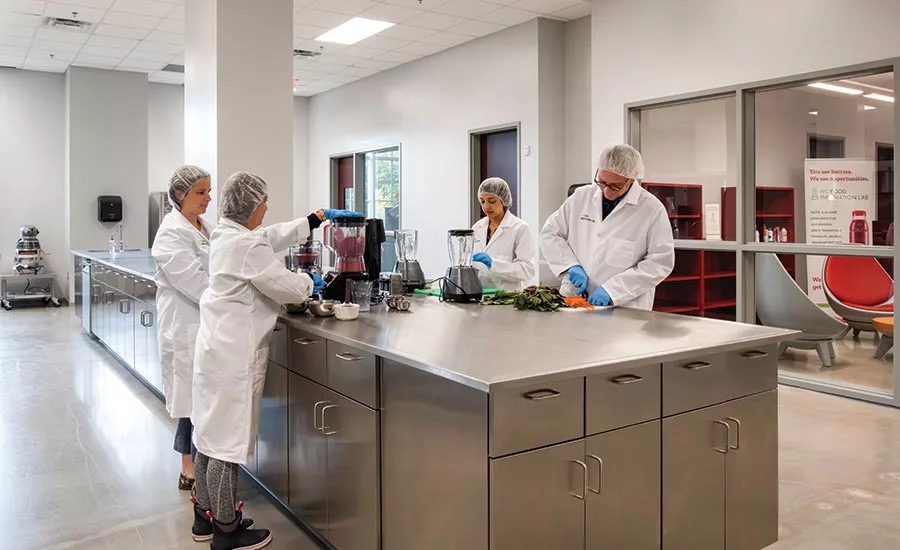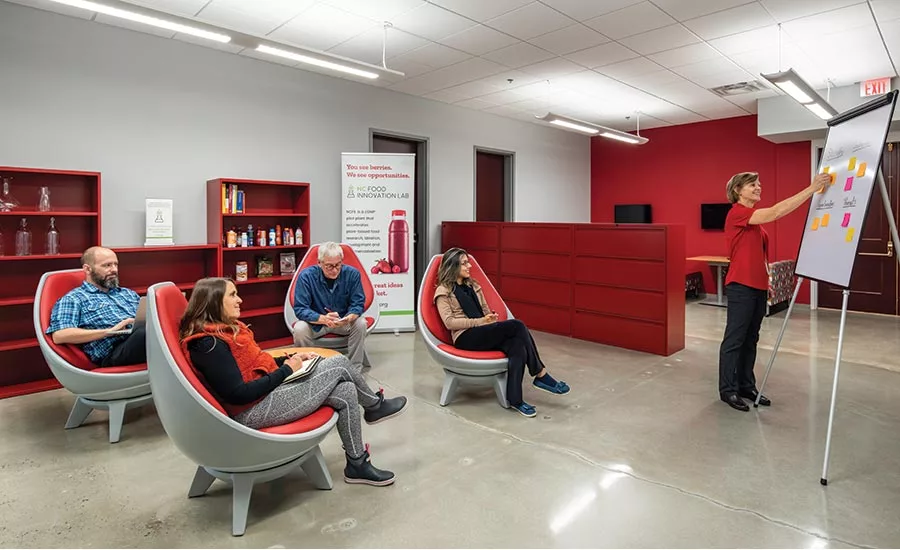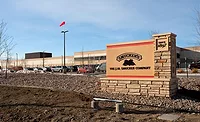North Carolina Food Innovation Lab takes aim at food production of the future

Housed at the North Carolina Research Campus, the North Carolina Food Innovation Lab is a state-backed project aimed at increasing food and beverage production in North Carolina.
All photos courtesy of Cameron Triggs/Triggs Photography

The test kitchen area will allow for product development and refining work before a product goes to production.

The Food Innovation Lab offers services ranging from concept to ideation to production, with specific areas of the lab designed to help processors and entrepreneurs take full advantage of what the Lab can offer.
Depending on who is asked, Kannapolis, N.C., is most well known for being the birthplace of either Parliament-Funkadelic’s George Clinton or NASCAR legend Dale Earnhardt Sr.
The mind behind “Atomic Dog” and the Intimidator don’t have a whole lot in common, but one thing they do share is a legacy of turning their respective fields on their heads—sometimes literally, in Earnhardt’s case.
While Bill Aimutis isn’t necessarily looking for the same level of fame in his role as executive director of the North Carolina Food Innovation Lab, he certainly wouldn’t mind having the same kind of impact on the food processing industry. The veteran food scientist has spent the last two years getting the facility off the ground, including hiring two team members with experience across a wide variety of food and beverage categories and experience with entrepreneurs. Aimutis and his team are looking forward to the lab being a testing ground for innovative food and beverage products for companies ranging from startups to massive multinational conglomerates.
While other innovation labs or similar facilities exist, they are mostly focused on research. What sets the North Carolina Food Innovation Lab apart is its capabilities in actual production of products, from the time materials come in one door and a finished product goes out the other.
But to get to that point, the facility had to be planned, designed and built in a way to accommodate not only immediate needs, but future needs as well. That created a number of challenges for Aimutis as well as CRB, which designed and built the facility.
It’s not quite the same as leading P-Funk on stage or saving a stock car when it gets loose in turn 3, but it’s probably been just about as nerve-racking as the lab went from idea to reality. Now the time has come for the project to come online, and interest in what the Lab can provide for the industry is already showing that the Lab is making a big splash.
From the top
The Lab is a state-supported project, housed at the North Carolina Research Campus. Initial funding for the project was approved by the state, with money allocated for the construction of the facility as well as operating funding for 10 years. Agriculture and agribusiness are a more than $80 billion a year economy in North Carolina, so the Lab was part of an effort to jump-start food and beverage production in the state.
“Our overall objective, as outlined by the state, is to grow the economy in the food processing area for North Carolina,” says Aimutis.
To do that, the Lab needed to be able to offer something food processors couldn’t find anywhere else. That goal was achieved with the facility being the only food innovation lab in the country that could offer a manufacturing area that is cGMP certified.
“We’ve cordoned off about 2,000 square feet of our pilot plant to operate under strict cGMP,” says Aimutis. “So we can produce small quantities or small volumes of products that are ready to eat or are ready to drink.
“We can do limited runs up to a couple thousand units," he says. “We scaled this plant to handle about 1,000 pounds of raw material a day, in an 8-hour shift.”
That capability means processors can rely on the Lab to do more than just research and ideation. When a product is ready to be run for a test market, the Lab can do that run and package it for sale, meaning the entire production process can be conducted from start to finish in the Lab.
To be able to do all that requires flexibility, which is where CRB’s challenges enter the picture. The task was to design a food plant that isn’t really a food plant, except for all the parts where it is. The Lab won’t be producing just one type of product, so it has to be adaptable and adjustable in order to serve the needs of customers ranging from small startups to big companies.
That meant flexibility in the entire design and construction process, says Pablo Coronel, PhD, director of food process for CRB.
“We had to figure out from the start how the materials were going to flow in and out of the space, and how people were going to flow in and out of the space,” he says. “The other big challenge was that we had to design a space flexible enough to support any processes and innovations that will be developed in the next 10 years, based on the processes that were planned for in the present.”
Ideation and Creation
While the Lab isn’t restricted in what kinds of products it can produce or what kind of materials it can use, Aimutis does see plant-based protein as a particular area of interest for the Lab and its customers. As more companies enter the market or existing companies refine their products, they’ll have to be able to respond to consumer feedback on taste and texture of items such as plant-based burgers. That’s where the Lab comes in.
“I liken this a little bit to where we were at 25 years ago with fat-free food,” Aimutis says. “Some of the foods that are out there right now are good and some are not good at all right now. There’s going to be a lot of room for improvement, and as we get better at processing and handling these types of products, we’ll continue to improve the flavors and textures that everyone’s looking for.”
That also ties back to the state’s interest in the Lab driving more food production. As previously mentioned, agriculture is a multibillion dollar industry in the state, with a stated goal of more than $100 billion annually. The state is a natural home for production of plant materials, and if processors can be close to both materials and an innovation lab that allows them to refine and perfect how to use those materials, then production facilities are the logical next step.
Those production facilities could be the next step for a startup with a good idea or a continuation of a larger company’s existing plans. The Lab has been drawing interest from both, Aimutis says, with the added bonus of interest from equipment suppliers due to the extent of the lab’s capabilities.
“I'd say 30-40% of the business we’ll be doing will probably be with multinationals and 30-40% will be with the entrepreneurs, and then we have equipment companies that are also wanting to work with us because of the upstream and downstream capability we have in processing food,” he says.
Food safety and protecting IP
Regardless of what size company the Lab is doing work for, there are concerns that had to be addressed upfront to ensure customers would be willing to do business. The first is food safety and preventing potential cross-contamination or unsanitary conditions.
Part of the plant is designed to the highest possible cGMP standards, which means tightly controlling who is allowed in the space and the process they have to go through to enter it. But processors might want to see the production process in action.
To solve this, part of the area has cameras that go to TVs in a conference room, so the process can be observed. In other areas of the plant where it’s feasible, observation windows have been installed to allow for in-person viewing of production. But windows create a whole new set of challenges, says Coronel.
“Observation windows are a challenge because you have to make sure that they will be cleanable, will not bring any contaminants and will not allow any leaking water or air from outside,” he says. “So that was quite challenging, and that was solved through a number of iterations.”
In addition to protecting the integrity of the products being produced, the Lab also had to have procedures in place for protecting intellectual property. No processor is going to want its recipes being available to another company, so safeguards needed to be put in place. Aimutis has made experience working with IP a priority for the staff hired so far, and education will be part of the new employee training process.
There will also be scheduling and logistical solutions to safeguarding IP, Aimutis says.
“For example, we wouldn’t want to have one of the major beverage companies in here against their competition on the same day,” he says. “But that's not to say we can’t have somebody who wants to do some type of frozen vegetable working with us and at the same time, we can have a beverage company in the other part of the plant.”
Powering up
The Lab has full production capabilities, which means it needs a utility infrastructure capable of meeting those demands. But with “what are we producing today/next week/next month” being an ongoing question, it was hard to define exactly what those demands will be at any given time.
To meet that challenge, Coronel and his team focused on flexibility and quick adaptation while designing the utility infrastructure. They built in extra electrical, water and compressed air capacity, as well as adding numerous access points for the utilities to allow for different processes and their different needs.
“Everything was built so it could be changed from one process to another really quickly,” says Coronel.
But that flexibility creates additional challenges when it comes to trying to manage a utility spend. The Lab’s goal is to operate in the most efficient manner possible. That’s a tricky target to hit when the production demands can swing wildly based on what project the Lab is undertaking.
Coronel and his team focused on maintaining environmental conditions to help mitigate the peaks and valleys of what resources the facility would need. Maintaining the necessary room temperature is a challenge when many pieces of equipment are running, so they prioritized equipment that would run cooler and not dump heat into the environment and put extra load on the HVAC. Steam condensate recovery units were installed to prevent steam powered units from putting steam into the environment, which could affect temperature and humidity.
Ultimately, CRB had to figure out what kinds of demands would be placed on the utility and production infrastructure in the future and accommodate them without knowing their exact details, says Coronel.
“We designed this center to be as efficient as possible within the constraints of not knowing what the Lab’s requirements will be in the future as they innovate and create new processes,” he says. “It sounds like magic, but that’s what we were able to do—look into the crystal ball.”
Multipurpose Lab
The Lab is also designed to offer services to the industry as a whole, not just customers who want the Lab to help them design the next big thing. The Lab will host courses and workshops several times a year, focusing on topics both big and small, says Aimutis.
“As people try to keep up with what's going on with the Food Safety Modernization Act, or even something as simple as ‘how do you rebuild a pump,’ we're going to be offering courses on that throughout the course of the year,” he says.
It all goes back to the original mission of the Lab, which is to be a force for driving food and beverage production in the state of North Carolina. But the interest in what the Lab can offer and the opportunities to work with companies from all areas of food and beverage production are quickly expanding that mission.
As Aimutis puts it, where the Lab is now and what it’s focusing on are in line with the original mission and the original vision. But as processors start to learn more about the Lab and what it can offer, the focus on being able to provide more than just research services is opening a lot of eyes.
“I think the receptiveness of what we're doing here is what maybe surprised us a little bit,” he says. “All of a sudden people are saying ‘Oh, you can do that. And others can't do that.’”
For more information:
North Carolina Food Innovation Lab, www.ncfoodinnovationlab.org
CRB, www.crbusa.com
Looking for a reprint of this article?
From high-res PDFs to custom plaques, order your copy today!






